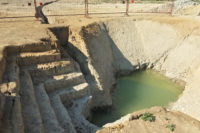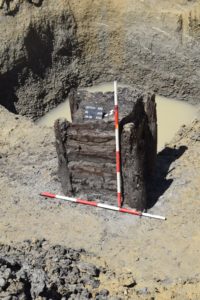 A prehistoric wooden well found in the Czech Republic has been tree-ring dated to 5256–5255 B.C., making it not only the oldest known wood well in Europe, but as far as we know the world’s oldest wooden structure. Discovered in 2018 during construction of the D35 highway near the town of Ostrov in western Czech Republic, the well was below the water table which kept the oak timbers from disintegrating to nothing and ensured the ring record was readable.
A prehistoric wooden well found in the Czech Republic has been tree-ring dated to 5256–5255 B.C., making it not only the oldest known wood well in Europe, but as far as we know the world’s oldest wooden structure. Discovered in 2018 during construction of the D35 highway near the town of Ostrov in western Czech Republic, the well was below the water table which kept the oak timbers from disintegrating to nothing and ensured the ring record was readable.
The 6th millennium B.C. saw the widespread transition in Europe from nomadic hunter-gatherer lifestyles to the cultivation of plants and raising livestock for foods. A necessary corollary of the vast societal transformation to the sedentary lifestyle was the building of permanent structures to house people and animals, and that required the use and able working of wood.
Wells are uniquely valuable archaeological examples of the Neolithic’s advances in timber construction, because the longhouses that characterized the new permanent settlements are today detectable only from their impact on the soil – postholes, ground plans — as the wood has long since rotted away. Because wells are, by definition, waterlogged, their timbers can be preserved in ring-countable condition for thousands of years and therefore be absolutely dated against tree-ring chronologies. For this area, the tree-ring width chronology has been established going back to 5481 B.C. from Czech oaks preserved in alluvial deposits.
 The well is square, its surviving walls 80×80 centimeters (32×32 inches) wide and 140 centimeters (4’7″) high. It was built by inserting planks into longitudinal grooves carved into thick corner posts at 90-degree angles. There are seven rows of planks extant. The wood of the corner posts is older than the rest of the structure. Their trunks were cut down in autumn/winter of 5259 or early winter 5258 B.C.
The well is square, its surviving walls 80×80 centimeters (32×32 inches) wide and 140 centimeters (4’7″) high. It was built by inserting planks into longitudinal grooves carved into thick corner posts at 90-degree angles. There are seven rows of planks extant. The wood of the corner posts is older than the rest of the structure. Their trunks were cut down in autumn/winter of 5259 or early winter 5258 B.C.
The trees — at least two feet in diameter — had to be felled, split and finished with precision, very advanced work to accomplish with tools of stone, bone, horn or wood. The tool marks preserved on the surface of the wood confirm the well was made by carpenters with sophisticated tools and methods.
Twelve Neolithic water wells are known to survive in Europe, most of them in eastern Germany. Four of them were discovered recently in eastern Germany just 100 miles north of Ostov. Published in 2012, the four wells at Altsherbitz, Brodau and Eythra were dendrochronologically dated to between 5200 and 5099 B.C. They were built with mortise and tenon joints or notched timbers that interlocked or cogged at the corners.
The Ostov well was recovered from the highway site en bloc so that archaeologists could excavate it in laboratory conditions at the University of Pardubice. The team has been soaking the wood in water to keep it from drying out, and in a new one for me, they’ve dumped 600 kilos (1322 lbs) of sugar into the water. The sugar solution seeps into the wood and eventually replaces the water in the cells with sugar, preserving it even once it’s out of the bath. It will take about a year for the wood to soak in the sucrose solution, after which the timbers will be dried slowly for the next six months. The well will then be reconstructed and put on display at the East Bohemian Museum in Pardubice.